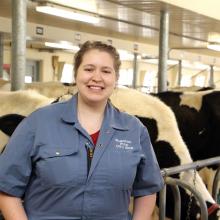The first three years of vet school involve a ton of written exams. We spend most of our Monday mornings filling out bubble sheets and short answer tests, and then we spend the month of April writing final exams on everything we’ve learned in the last year. We get to be very good at taking tests, at memorizing things and regurgitating information. But now we start our fourth year, and we begin a whole new type of learning.
You see, the last few weeks I have been asking more questions about “how” to do something. Usually at the end of a day, my fellow externship student, Amy, and I tell each other about all the cases we’ve seen. It’s not enough to just say “that’s so cool that you got to see that!” it’s now more about saying “that’s so cool! How exactly did they do that procedure… describe it to me.” When I watch one of the vets do a seemingly routine procedure, I ask “are there any tricks to doing that?” I know that they’ve done it a million times and it’s second nature, so they may not even realize that they do certain things to make everything look so seamless.
For example, I have been going on herd health visits for a few weeks now. One of the things that some producers do is scope fresh (or recently calved) cows. This is a direct visualization of the reproductive tract to look for any pus or abnormal discharge that would indicate infection of the uterus after calving. It involves keeping the outer vulva clean, then inserting a glass tube into the vagina, then shining a flashlight into the tube while looking up the tube at the same time to look for any discharge. This can all be done with basically one hand without having to take your poop-covered rectal sleeve off! I watched the vet do this many times, and then in my third week, he asked me to do the scoping. I was a bit nervous, but I felt like I could do it.
So I grabbed the cow’s tail with my left hand, which was covered with my dirty rectal sleeve, to lift it out of the way, dipped my paper towel in the soapy water to clean her vulva with my right hand, and reached back to grab one of the scopes. I let the tail slip a little and I turned back to see that I had dirtied her again with my rectal sleeve. So I cleaned her again, then grabbed a scope and inserted it with my right hand. My cow started to swing back and forth as I was reaching for my flashlight and while I was trying to balance my flashlight in my hand, I tried to stop my scope from slipping out of the cow. My right hand could only hold so much and I watched in horror as the glass scope smashed on the ground. I was super embarrassed! I was assured that it happens even to seasoned pros, but I still felt sorry that I couldn’t handle this routine task!
I realized that I hadn’t paid close enough attention to the process. It’s not enough to just be able to list the steps, whether that’s on an exam, or in real life. I must closely watch all the motions and envision how I would do it myself.
Since then, I have watched scoping more closely, and I have scoped several cows successfully now without any breaking of scopes. Now I observe every procedure carefully and ask the vets for any tips along the way. I’m learning things so that I know how to do it, not just to “know” it.
